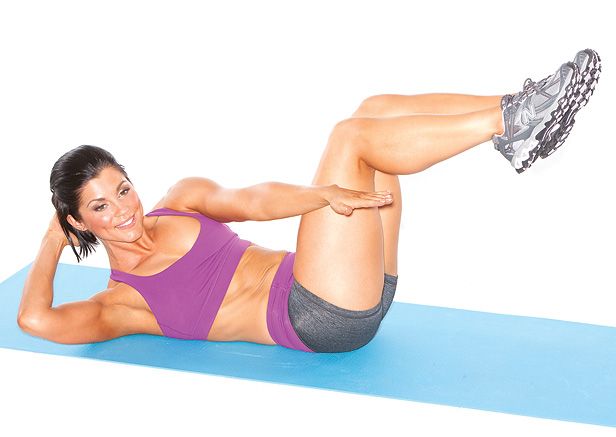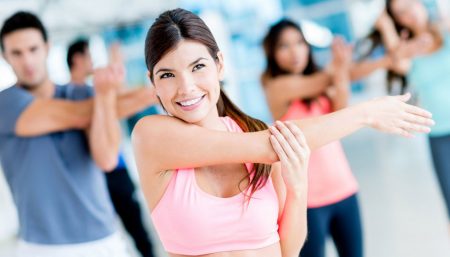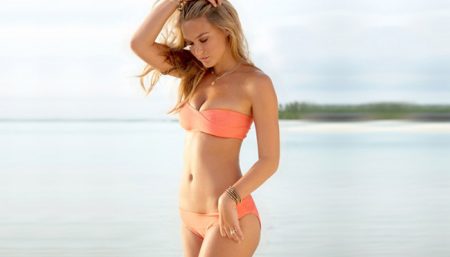Oblique Crunches (Upper & lower abs, Obliques)
Lie flat on your back, letting both your legs fall to the left side so you’re resting on your right hip. If your top leg won’t go all the way down, let it rest in a comfortable position as close to the other leg as possible.
Keeping your shoulders as close to parallel to the floor as possible, use your ab muscles to raise both shoulder blades off the floor, bringing your rib cage toward your pelvis. Then lower your torso in a controlled motion. Repeat the movement with your legs on the opposite side.
Tips
• Focus your mind on feeling your abs do the work.
• Keep constant tension on your abs.
• Don’t rest at the bottom of the movement.
• Make sure you move your shoulder blades off the floor. Don’t move just your neck and head.
• Try not to lead the movement with a single shoulder. Keep your shoulders parallel to the floor.
Toe Touches With a Twist (Upper & Lower abs , Obliques)
Lie flat on your back, legs straight up (knees unlocked) and perpendicular to your body, arms extended toward the ceiling.
Use your abs to raise your right shoulder of the floor, touching the outside of your left little toe with your right hand. Lower your shoulder back to the floor and repeat the movement to the opposite side, touching your left hand to the outside of your right little toe.
Tips
• Concentrate on feeling your abs do the work.
• Keep the movement controlled. Don’t jerk up to reach your toes.
• Don’t rest at the bottom of the movement. Keep tension on your abs.
• If you can’t touch your toes, just touch as far as you can. Your range of motion will improve with work.
• Keep a neutral spine.
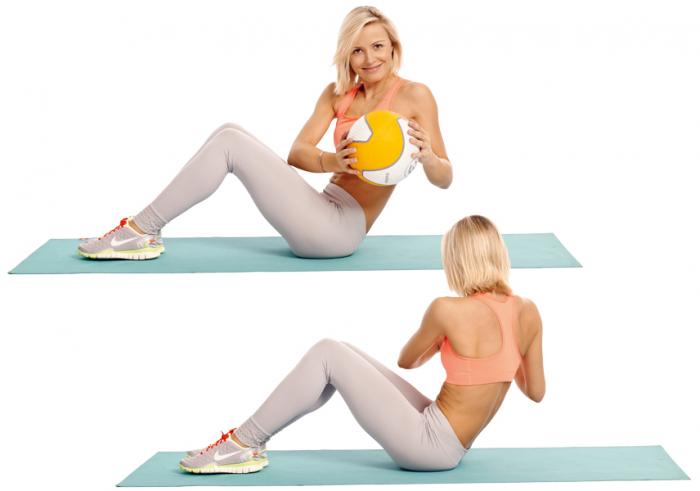
Russian Twists (Upper & Lower abs, Obliques)
Find a position of balance on your buttocks, feet in the air extended halfway out and hands clasped and extended out in front of you.
From this position, twist side to side while maintaining your balance on your buttocks, keeping constant tension on your abs. Repeat.
Tips
• Don’t crunch your body together. Keep good posture and try to relax into the position.
• Go through a full range of motion, twisting as far as you can, then as far to your left as you can.
• Your neck and head should remain lengthened and aligned with the rest of your spine.
• Don’t move your head from side to side
• Maintain a stable position on your buttocks.
V-Ups (Upper & Lower abs)
Lie flat on your back, legs fully extended (knees unlocked), heels resting on the floor, and arms extended over your head.
Use your abs to simultaneously raise your torso and legs together. Then, in a controlled motion, lower your legs and torso back to the starting position. Repeat
Bent-Knee Variation: Same starting position, except you have your knees bent and your feet flat on the floor. The Movement is the same, except you keep your knees bent throughout the range of motion and you end each repetition in a bent-knee position.
Tips
• Focus on feeling your abs pull your torso and legs together.
• Keep the movement controlled—don’t jerk yourself up.
• Don’t rest your arms and legs at the bottom of the movement.
• Focus your mind on feeling your abs do the work.
• The bent-knee version is easier and puts less stress on your back.
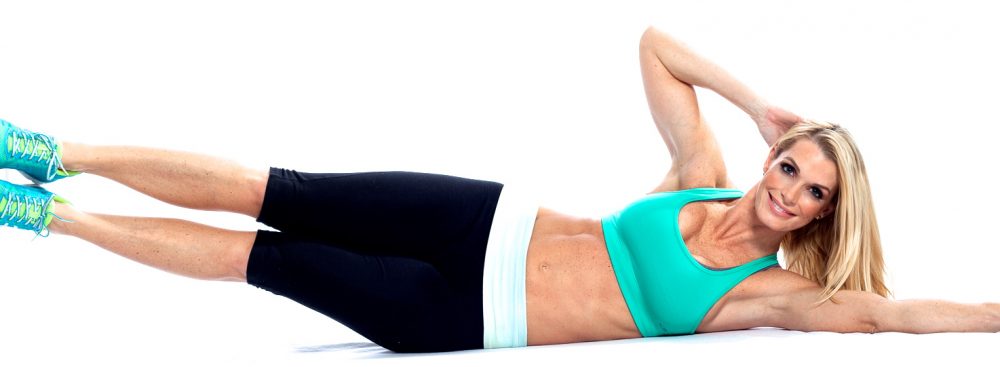
Side Double Crunches (Upper & Lower abs & Obliques)
Lie on your right buttocks, legs fully extended (knees unlocked), right arm out front for support, and left hand behind your left ear.
Use your abs to simultaneously raise your legs and torso off the floor, bringing your knees and chest together. Then return to the starting position. Repeat the movement until you have completed your set. Then switch sides.
Tips
• Don’t let your legs and torso rest on the floor at the bottom of the movement.
• Focus your mind on feeling your abs do the work.
• Don’t pull your head forward with your hand.
Begin with one set and go on to do 2 sets of these exercise of repetitions you can hold in the right posture. Breathe deeply all along.
Disclaimer
The Content is not intended to be a substitute for professional medical advice, diagnosis, or treatment. Always seek the advice of your physician or other qualified health provider with any questions you may have regarding a medical condition.
